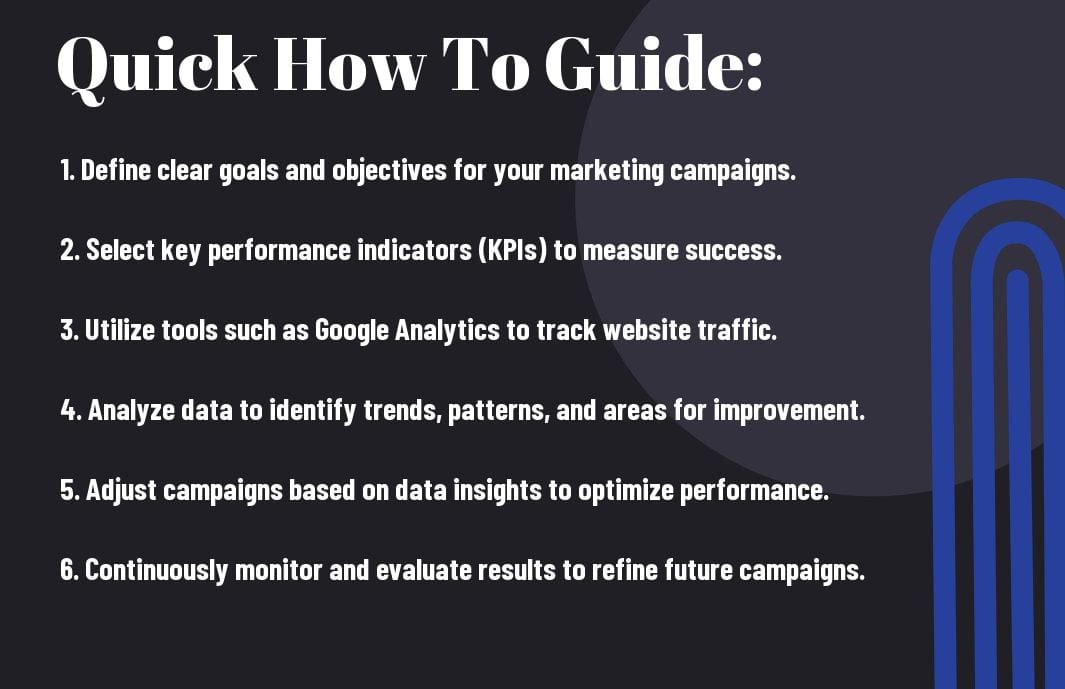Analytics have become a crucial tool for businesses looking to maximize their marketing efforts. Understanding how to measure and improve your campaigns through data-driven insights can make the difference between the success and failure of your marketing strategies. In this comprehensive guide, we will demystify the world of marketing analytics, breaking down complex concepts into actionable steps that will help you optimize your campaigns effectively.
Key Takeaways:
- Define Key Performance Indicators (KPIs): Before starting any marketing campaign, make sure to clearly define your KPIs to measure success. This could include metrics such as conversion rates, website traffic, or customer acquisition cost.
- Utilize Marketing Analytics Tools: Leverage tools like Google Analytics, social media insights, and email marketing platforms to track and analyze the performance of your campaigns. These tools can provide valuable data to help optimize your strategies.
- Continuous Optimization: Regularly review your marketing analytics data to identify areas for improvement. Test different strategies, measure the results, and make data-driven decisions to continuously optimize your campaigns for better performance.

Setting Up Your Analytics Tools
Choosing the Right Analytics Software
Clearly, selecting the right analytics software is crucial to effectively measure and improve your marketing campaigns. There are various options available in the market, each with its own set of features and capabilities. It’s important to choose a software that aligns with your business goals and objectives. Consider factors such as the level of customization, ease of use, integrations with other tools, and scalability.
How to Set Up Tracking for Your Campaigns
With setting up tracking for your marketing campaigns, the key is proper implementation. This involves adding tracking codes to your website, creating custom URLs, and setting up conversion goals. Tracking allows you to monitor the performance of your campaigns in real-time and make informed decisions based on the data collected. Make sure to regularly audit and update your tracking setup to ensure accuracy and reliability.
Tracking provides valuable insights into the effectiveness of your marketing efforts and helps you optimize your strategies for better results. By leveraging data-driven analytics, you can identify trends, patterns, and areas for improvement, ultimately enhancing the overall performance of your campaigns.
Identifying Key Metrics and KPIs
Defining Your Campaign Goals
To effectively measure the success of your marketing campaigns, you must first define clear campaign goals. These goals should align with your overall business objectives and be specific, measurable, achievable, relevant, and time-bound (SMART). Whether your goal is to increase brand awareness, drive website traffic, generate leads, or boost sales, it’s crucial to establish these objectives before delving into the world of marketing analytics.
Tips for Selecting Relevant Metrics
When considering selecting relevant metrics and key performance indicators (KPIs) to track, it’s imperative to focus on those that directly align with your campaign goals. Avoid getting overwhelmed by data and instead, hone in on the metrics that truly matter. Consider metrics like conversion rates, customer acquisition cost, return on investment (ROI), and customer lifetime value.
- Focus on metrics that reflect progress towards your campaign goals
- Avoid vanity metrics that don’t provide actionable insights
- Ensure the metrics you choose are measurable and trackable over time
Relevant metrics should provide meaningful insights into the performance of your campaigns and help you make data-driven decisions. Your chosen metrics should guide you towards improving your marketing efforts and achieving your desired results. Assume that using the right metrics can make a substantial difference in your overall campaign effectiveness.
Collecting and Analyzing Data
How to Collect Data Effectively
For any marketing campaign to be successful, data collection is crucial. Clearly outline your goals and define the key performance indicators (KPIs) you want to measure. This will help you focus on collecting only relevant data that aligns with your objectives. Make use of tools like Google Analytics, social media insights, and CRM platforms to gather data efficiently. Regularly monitor and track data to ensure you’re on the right path and make adjustments as needed to improve campaign performance.
Analyzing Data for Insights: How-To Guide
Guide yourself by setting up a structured approach to analyze the data you collect. Start by cleaning and organizing your data to ensure accuracy. Utilize data visualization techniques like charts and graphs to identify trends and patterns. Guide your analysis by asking specific questions about your data to uncover insights that can guide your marketing decisions. Incorporate A/B testing and segmentation to explore deeper into understanding your audience and their behaviors.
Collecting and analyzing data is a continuous process that requires attention to detail and a strategic mindset. Embrace advanced analytics tools to explore deeper into your data and extract meaningful insights that can drive the success of your marketing campaigns.
Understanding the Customer Journey
Many businesses struggle to understand the intricacies of the customer journey, which is the path a customer takes from initial contact with your brand to conversion and beyond. It’s crucial to grasp this journey to optimize marketing strategies and enhance customer experiences. By leveraging marketing analytics, you can gain valuable insights into customer behavior, preferences, and interactions with your brand throughout their journey.
Mapping the Customer Journey with Analytics
Understanding the customer journey involves mapping out each touchpoint a customer encounters along the way. With analytics tools, you can track and analyze these touchpoints to gain a holistic view of the customer experience. By segmenting data based on different stages of the journey, you can identify patterns, trends, and opportunities to improve your marketing campaigns.
Identifying Critical Touchpoints and Conversion Factors
Even more crucial than mapping the customer journey is identifying critical touchpoints and conversion factors that influence customer decisions. These touchpoints can be website visits, social media interactions, email engagements, or purchases. By using analytics to measure the effectiveness of each touchpoint and conversion factor, you can optimize customer interactions and drive better results.
- Website visits: Analyze website traffic and user behavior to understand how customers engage with your site.
- Social media interactions: Track social media interactions to identify popular content and engagement levels.
- Email engagements: Monitor email open rates, click-through rates, and conversions to gauge the impact of your email campaigns.
Knowing which touchpoints and conversion factors are most impactful can help you allocate resources efficiently and tailor your marketing efforts to better serve your customers.
Optimizing Campaigns Using Data-Driven Insights
Once again, we explore into the critical aspect of optimizing marketing campaigns through data-driven insights. Understanding how to measure and improve your campaigns is key to achieving your marketing goals. By leveraging marketing analytics, you can gain valuable insights into what is working and what needs improvement in your campaigns.
How to Use A/B Testing for Campaign Improvement
You can enhance your marketing campaigns by implementing A/B testing, a method where you compare two versions of a campaign to see which one performs better. This method allows you to make data-backed decisions, ensuring that you are maximizing the effectiveness of your campaigns. By testing different elements such as ad copy, imagery, or calls-to-action, you can identify the most impactful strategies for your target audience.
Leveraging Analytics for Better Targeting
Leveraging analytics for better targeting involves using data insights to identify and reach your ideal audience more effectively. By analyzing demographic information, behavior patterns, and engagement metrics, you can create targeted campaigns that are more likely to resonate with your audience. This approach can lead to higher conversion rates and a better return on investment for your marketing efforts.
Better targeting not only improves the performance of your campaigns but also helps you optimize your budget by focusing on the most valuable segments of your audience. By understanding your audience’s preferences and behaviors, you can tailor your messaging to speak directly to their needs and interests, increasing the likelihood of a positive response.
Reporting and Communicating Analytics Findings
Unlike standalone data analysis, marketing analytics requires a strategic approach to reporting and communicating findings effectively. In my blog post Demystifying Marketing Analytics, I emphasized the importance of clear and concise reporting to drive actionable insights from your data.
How to Create Compelling Reports
An necessary aspect of creating compelling reports is to tailor the content to the audience’s level of understanding and interest. Start by highlighting the key performance indicators (KPIs) that are relevant to your stakeholders. Utilize visual aids such as charts and graphs to present data in an easily digestible format. This allows for quick comprehension of complex analytics findings and facilitates informed decision-making.
Tips for Presenting Data to Stakeholders
To effectively present data to stakeholders, it is crucial to customize your message to resonate with their priorities. Begin by outlining the objectives of the marketing campaign and how the analytics findings align with these goals. Clearly articulate the ROI (Return on Investment) metrics to demonstrate the impact of the campaign on the bottom line. This not only emphasizes the value of marketing efforts but also fosters trust and collaboration with stakeholders.
- Customize your message to resonate with stakeholders’ priorities.
- Clearly articulate the ROI (Return on Investment) metrics to demonstrate the impact of the campaign.
- This approach not only emphasizes the value of marketing efforts but also fosters trust and collaboration with stakeholders.
Compelling reports and presentations not only convey data insights but also inspire action and drive business growth. By adopting a strategic approach to reporting and communication, you can effectively convey the impact of marketing analytics on business outcomes. Keep in mind, the way you package and present data can make all the difference in gaining buy-in and driving success.
Future Trends in Marketing Analytics
Predictive Analytics and Machine Learning
All marketing professionals need to keep an eye on the rapidly evolving field of Predictive Analytics and Machine Learning. These technologies offer the ability to leverage data in unprecedented ways, allowing for predictive modeling and sophisticated pattern recognition. You can now anticipate consumer behavior, predict market trends, and optimize campaigns with greater precision than ever before. By harnessing the power of algorithms and advanced statistical techniques, you can take your marketing efforts to the next level.
The Role of Big Data in Marketing Decisions
In today’s data-driven world, you cannot underestimate the importance of Big Data in shaping your marketing decisions. Analytics tools enable you to collect, analyze, and interpret vast amounts of information from various sources. This wealth of data empowers you to make informed decisions based on real-time insights and trends. By tapping into the potential of Big Data, you can target your audience more effectively, personalize your messaging, and ultimately drive better results for your marketing campaigns.
FAQ
Q: What is marketing analytics?
A: Marketing analytics is the practice of measuring, managing, and analyzing marketing performance to maximize effectiveness and optimize return on investment (ROI).
Q: Why is marketing analytics important?
A: Marketing analytics provides valuable insights into the performance of marketing campaigns, helps in identifying areas for improvement, and enables data-driven decision-making to achieve business objectives.
Q: What are the key metrics in marketing analytics?
A: Key metrics in marketing analytics include conversion rate, customer acquisition cost (CAC), return on investment (ROI), customer lifetime value (CLV), click-through rate (CTR), and engagement metrics like likes, shares, and comments.
How can marketing analytics help in measuring campaign performance?
A: Marketing analytics can help in measuring campaign performance by tracking key performance indicators (KPIs), analyzing data from various channels, and providing insights into the effectiveness of marketing strategies in reaching target audiences.
Q: What are the common challenges in marketing analytics?
A: Common challenges in marketing analytics include data quality issues, siloed data sources, lack of skilled resources for data analysis, interpreting complex data sets, and aligning metrics with business goals.
Q: How can businesses use marketing analytics to improve their campaigns?
A: Businesses can use marketing analytics to improve their campaigns by identifying high-performing channels, refining targeting strategies, personalizing messaging based on customer behavior, optimizing ad spend, and experimenting with new tactics based on data insights.
Q: What tools are available for marketing analytics?
A: Some popular tools for marketing analytics include Google Analytics, Adobe Analytics, HubSpot, SEMrush, Moz, and Hootsuite, which offer features for tracking, analyzing, and reporting on marketing performance across multiple channels.




